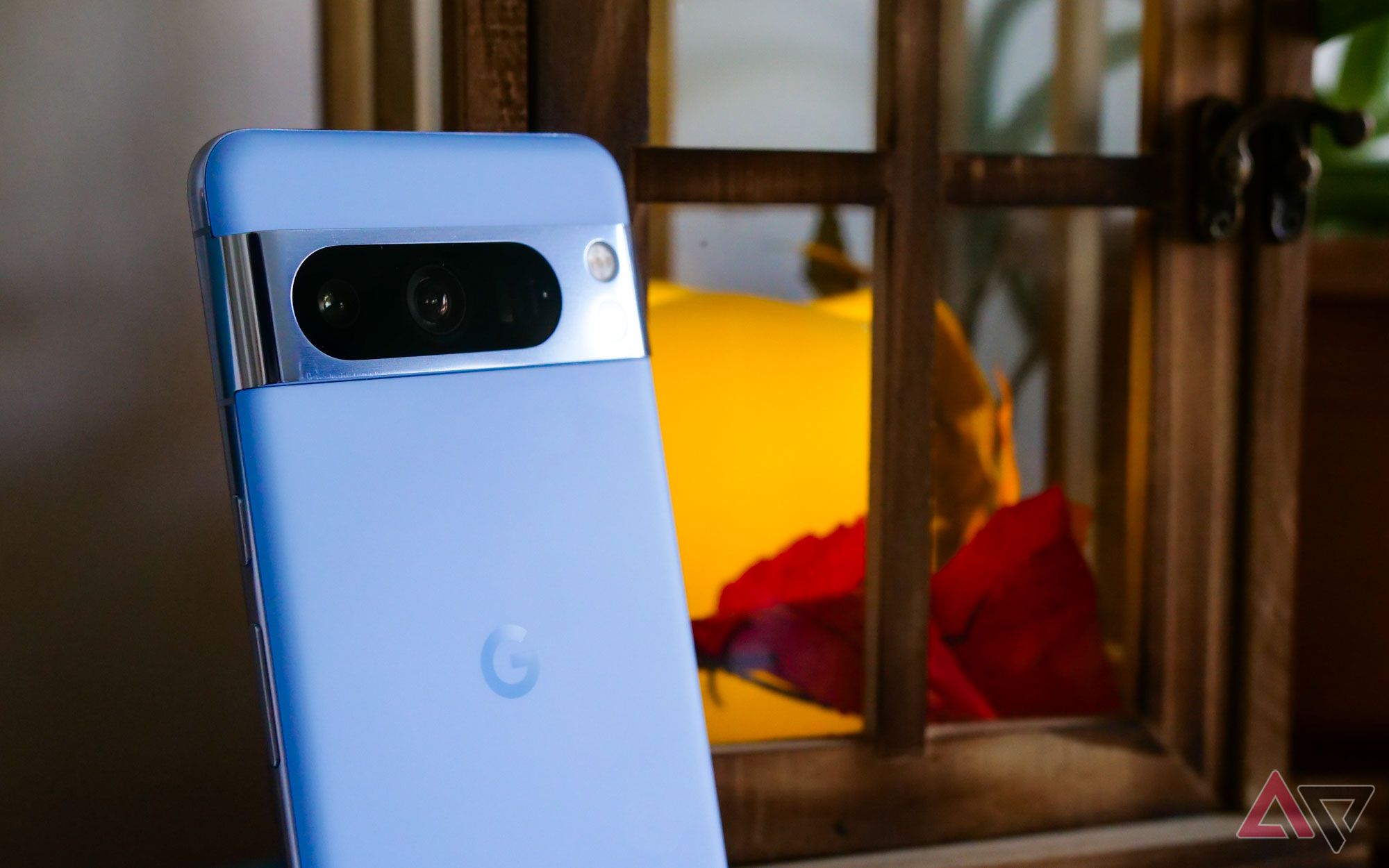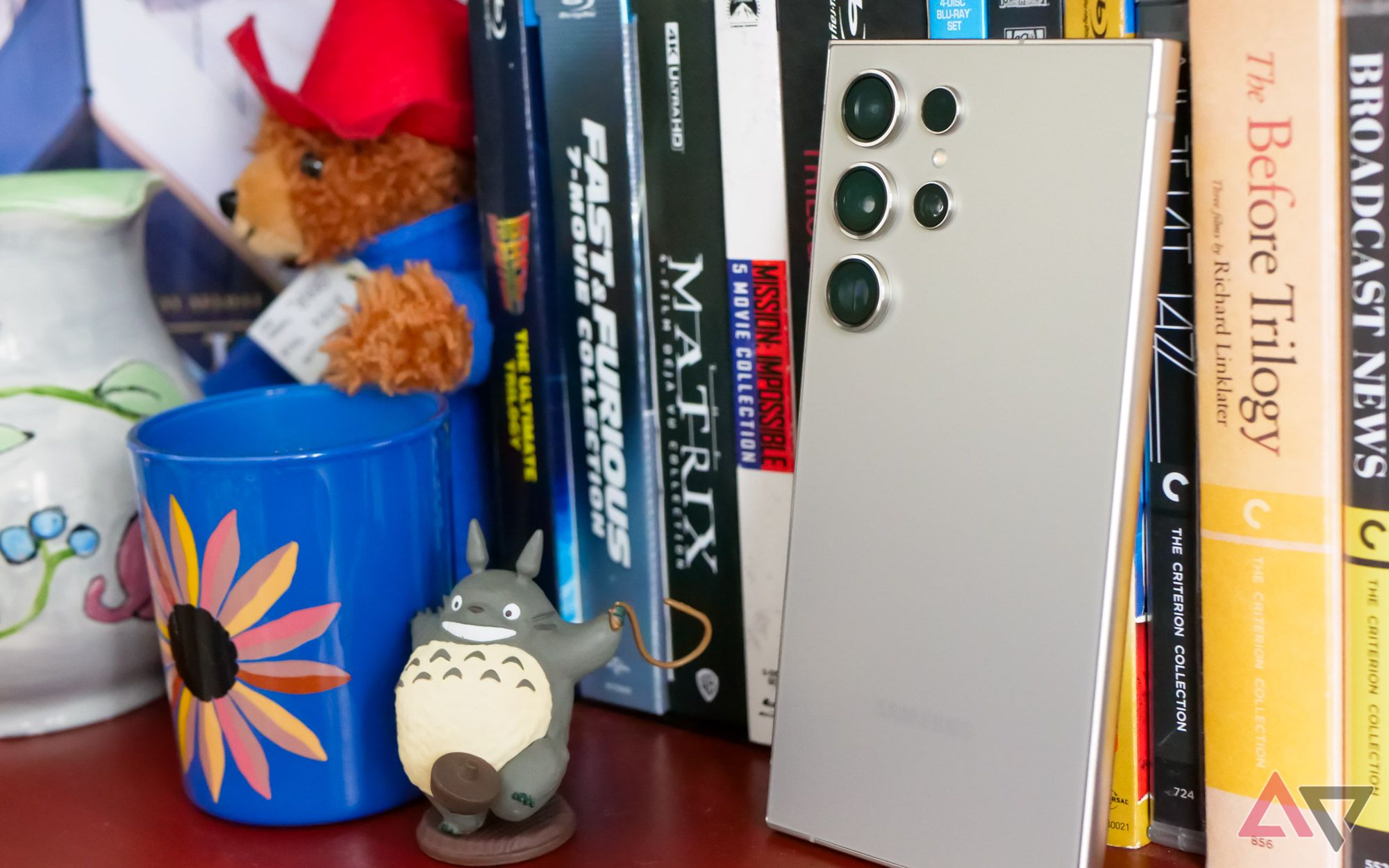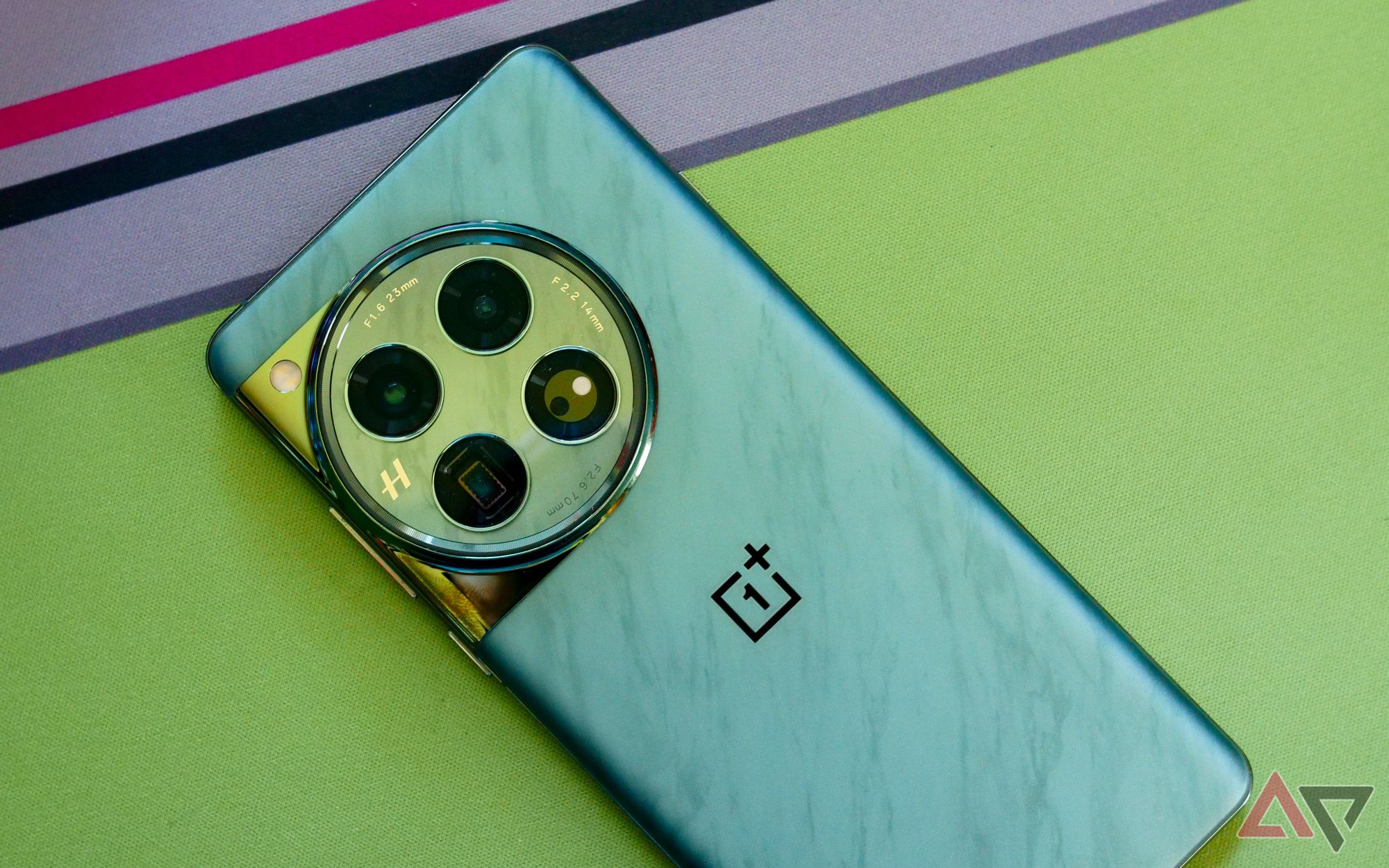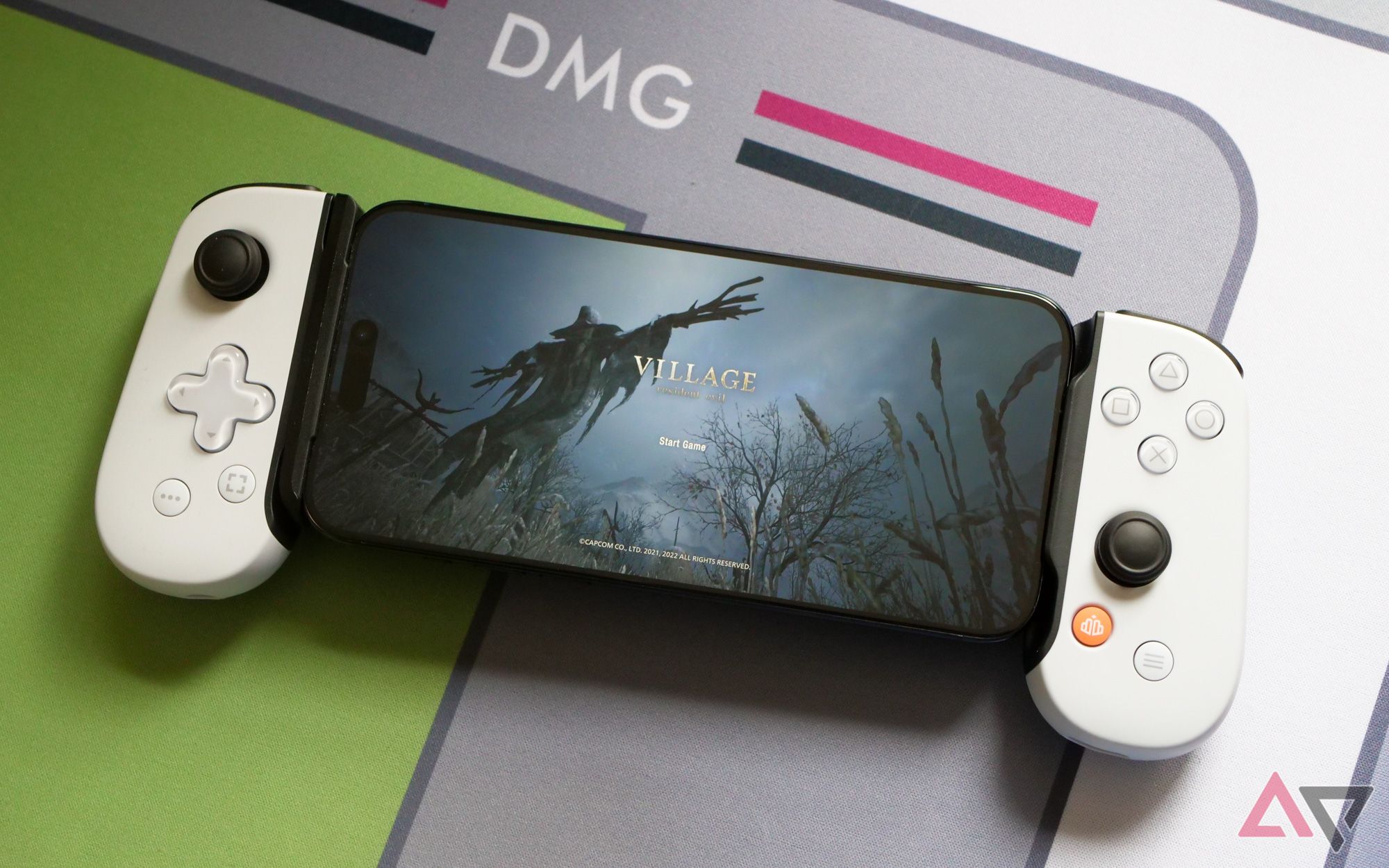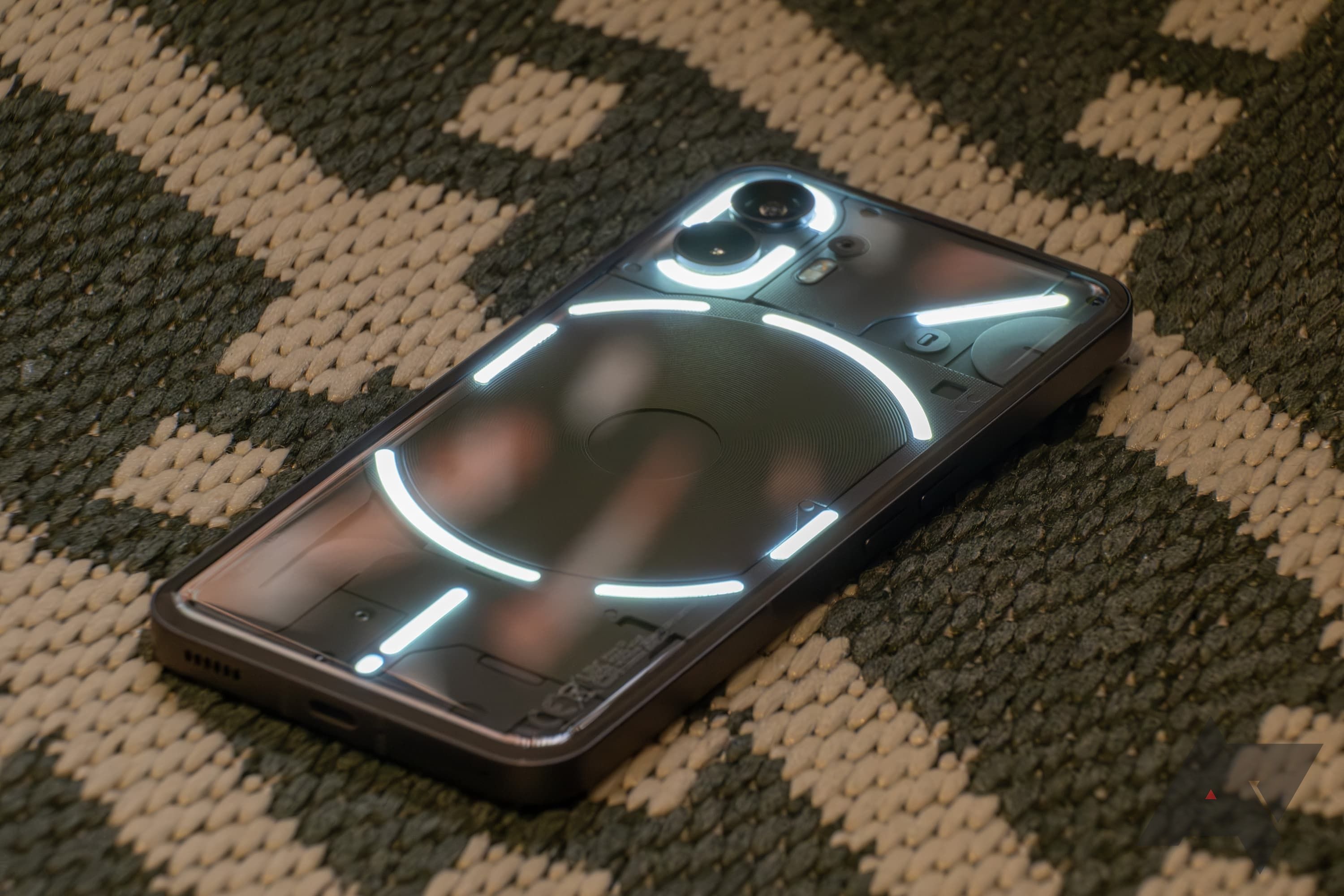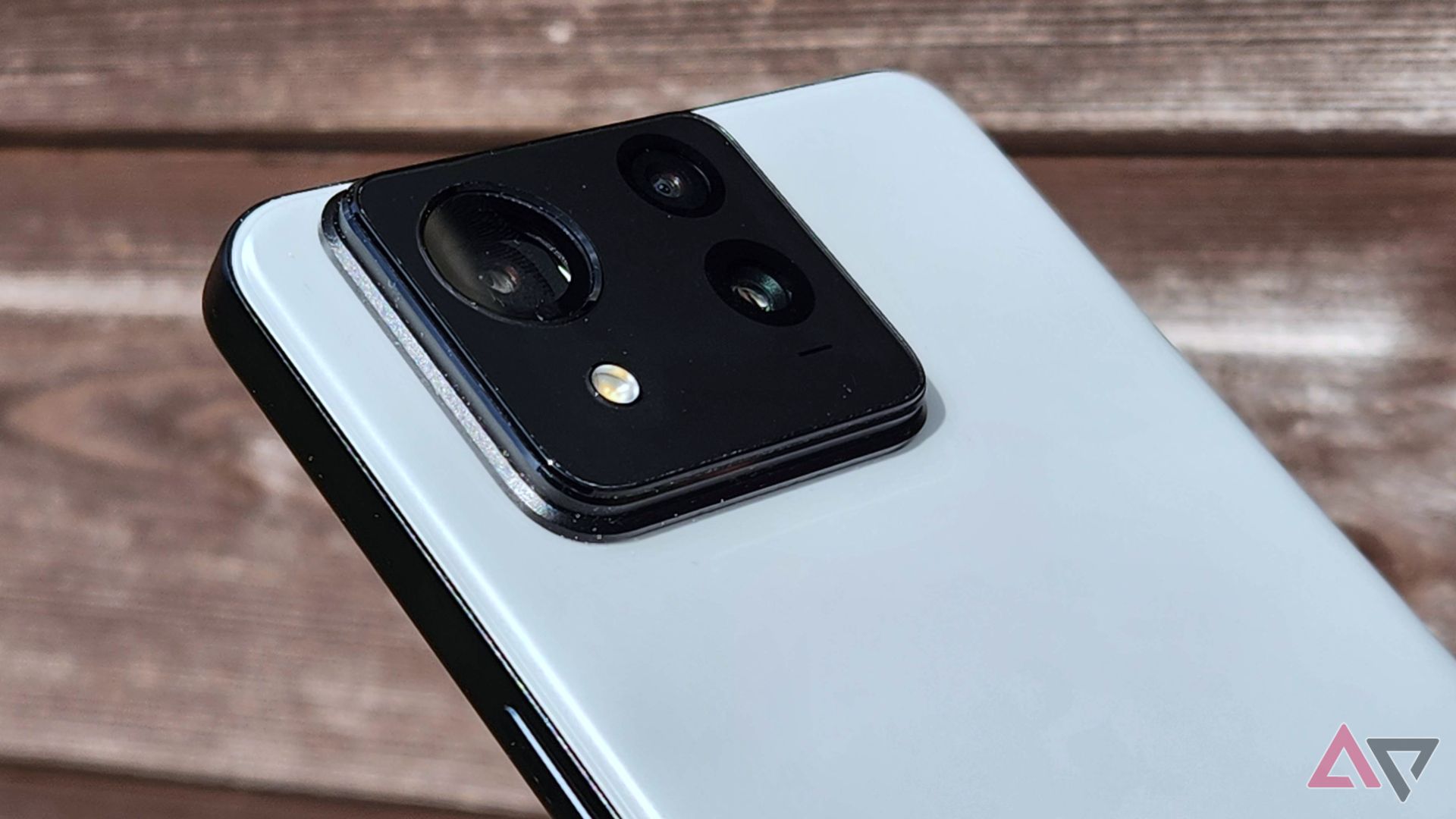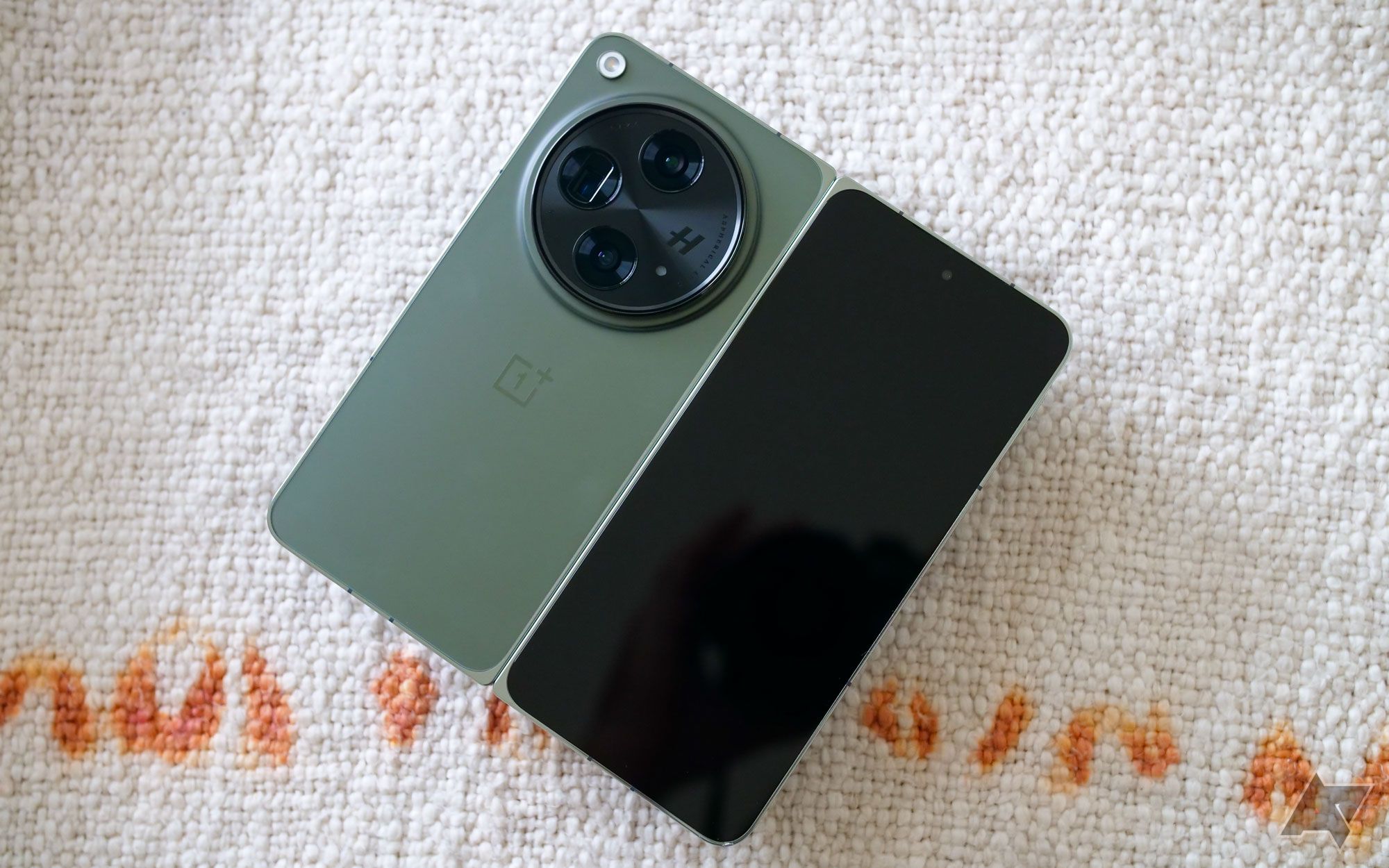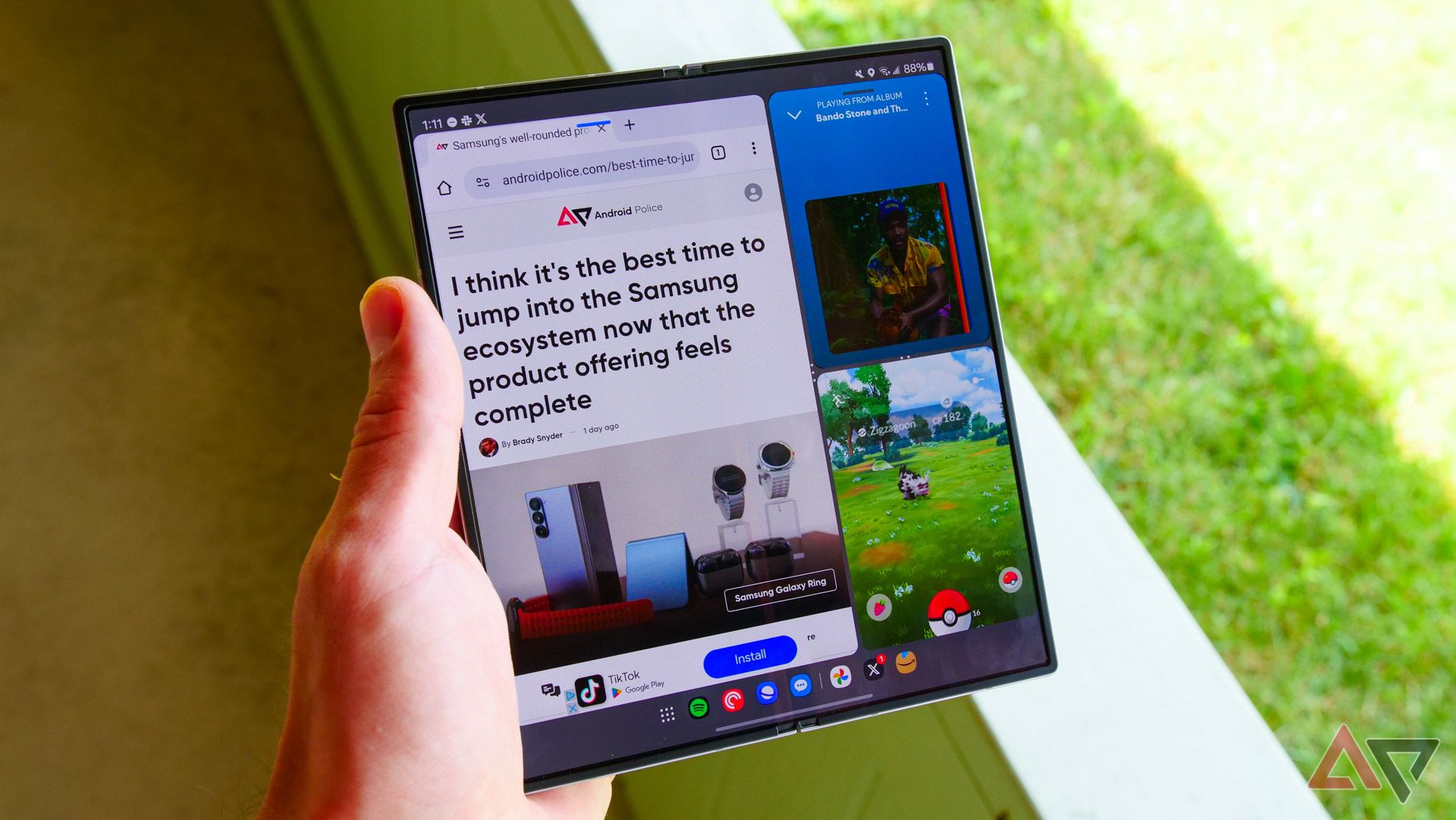Although there was a time when a 6.8-inch smartphone would have been considered absurdly massive and unwieldy — a category of products we once affectionately called “phablets” — larger phones have become mainstream. These days, even the best small phones have at least 6-inch screens, and many of the best Android phones easily land in the 6.7-inch territory.
There are a lot of advantages to a larger phone, including a big screen that makes your games pop and text more readable, bigger batteries that last longer, plus powerful chipsets that can efficiently handle the most demanding tasks. Big phones also typically have the best cameras, as there’s more room inside for high-zoom periscope lens systems and larger camera sensors that can capture more light.
Basically, whatever your needs are for a larger phone, you can be certain there’s one out there ready to satisfy you.
Big phones with no compromises
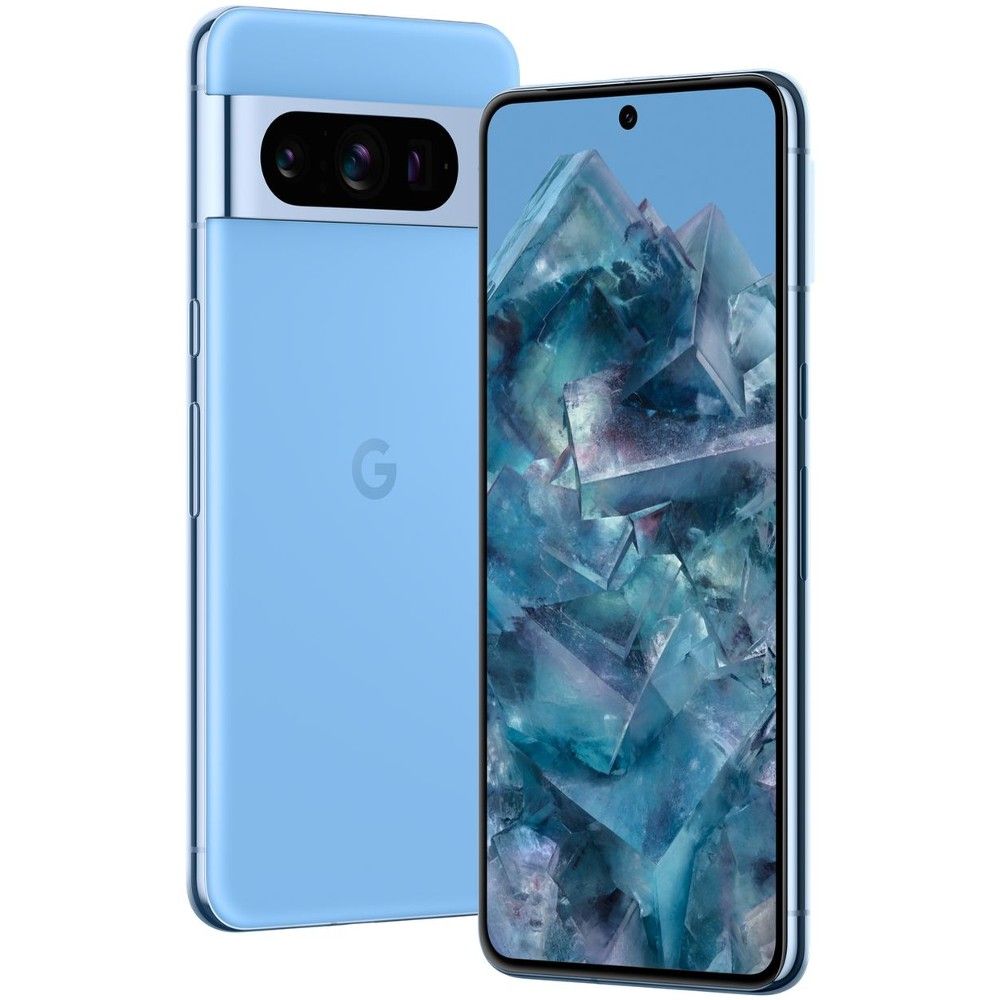
Best overall
Google Pixel 8 Pro
The master of all trades
Google’s Pixel 8 Pro remains the most well-rounded flagship you can buy, thanks to its accessible price tag, excellent photography features, and a new Tensor G3 chip that delivers both raw performance and advanced AI features. Add a fit and finish that’s even better this year, and it’s easily the best big phone for most people.
- Comfortable new design
- Excellent camera system
- Solid performance
- Not all AI features are fully baked
- Pricier
Google’s Pixel 9 lineup may be just around the corner, but that doesn’t mean the current Pixel 8 Pro isn’t still a great pick. For now, at least, it retains the crown for not only the best big phone you can buy, it’s also the best Android phone, period.
That’s thanks to Google’s excellent balance of elegant design and premium features at a price that won’t break the bank. Google’s Pixel phones have often graced the top of our lists, but the Pixel 8 Pro has eliminated many of the compromises that might have made you think twice about prior models.
For one thing, Google’s latest Tensor G3 chip packs plenty of power for computational photography and other AI features, but without the efficiency or heating issues of its predecessor. That means you can enjoy the latest mobile games without sacrificing battery life or dealing with a phone that may get too hot to handle.
The expansive 6.7-inch Super Actua display continues to be gorgeous, but we found the flat edges and matte glass back really take things up a notch. It’s not a revolutionary new design, but the little things add up, resulting in a phone that feels much better in the hand despite its larger size. Oh, and did we mention Bay blue is one of the most fetching colors Google has put out in recent years?
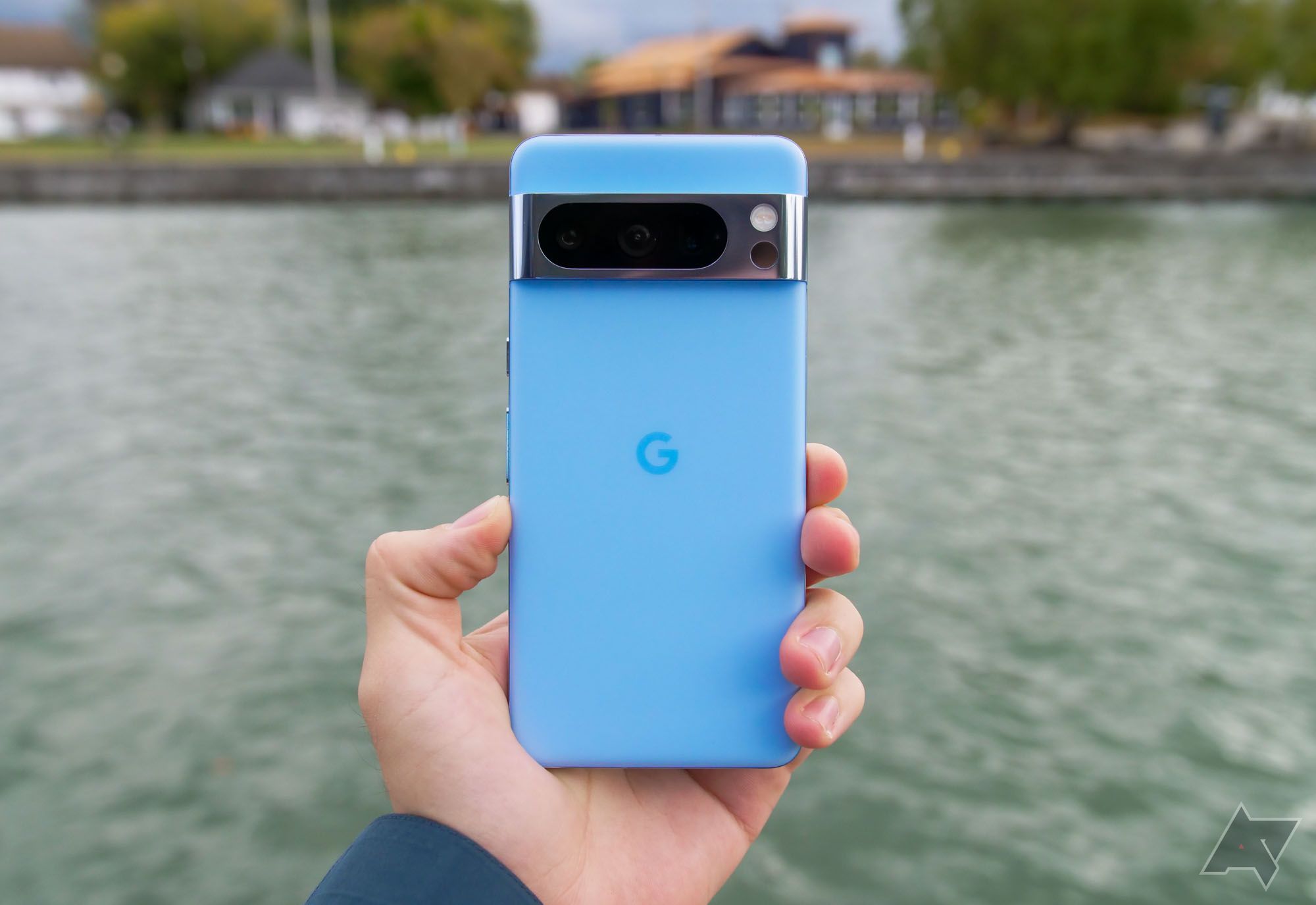
Read Our Review
Google Pixel 8 Pro review: Living up to its name
If you want to see the future of Google, the Pixel 8 Pro is the phone to buy
Of course, the real win for Google’s Pixel 8 Pro is the same as it’s been for years: it’s simply the best camera system you can get on a mobile phone.
Google’s AI-powered photography features are second to none and allow the phone to punch above the weight class of its sensors to produce amazing photos, with a natural balance of colors and lighting that avoids the oversaturation that some other popular phone makers are known for. Google also takes its high dynamic range processing to new heights with ultra HDR to punch things up to a whole new level.
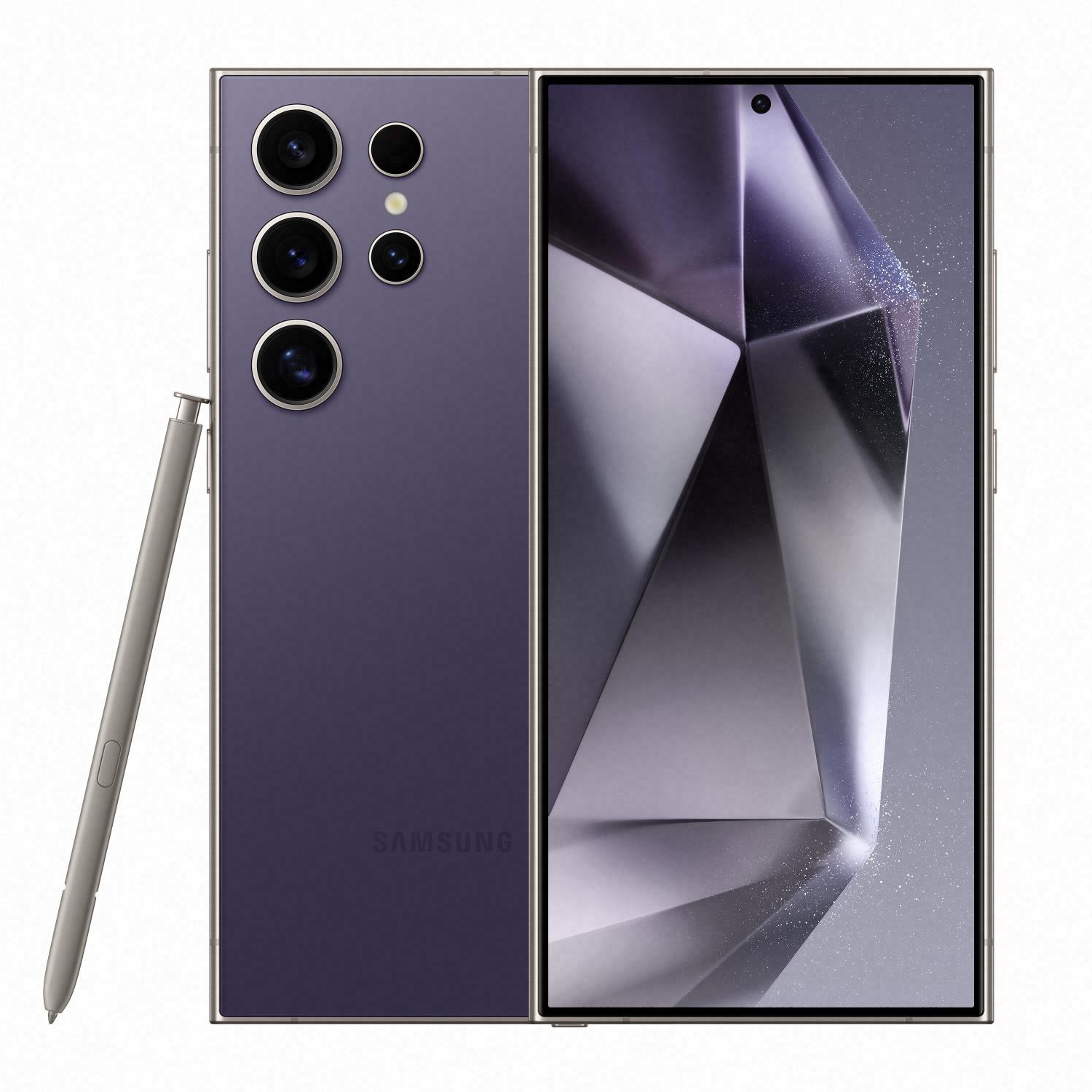
Premium pick
Samsung Galaxy S24 Ultra
The ultimate flagship
The Samsung Galaxy S24 Ultra continues the tradition of putting “premium” in high-end flagships. This year’s model features a titanium frame, an expansive and gorgeous flat touchscreen, and an unprecedented seven years of software updates. The optimized Snapdragon 8 Gen 3 chip can also handle anything you throw at it.
- The best display you can get
- A solid and versatile camera system
- Excellent performance and multi-day battery life
- Cameras struggle with motion
- Expensive
For those who want to go all out, Samsung’s Galaxy S24 Ultra is a nearly no-compromise smartphone that easily justifies its premium price tag. For one thing, you get the most powerful chip on the market today with Qualcomm’s Snapdragon 8 Gen 3 for Galaxy, a bespoke edition of the chip that’s optimized for Samsung’s smartphones, including its new suite of Galaxy AI features.
With all the power under the hood, there’s no app or game this phone can’t handle, to the point where we found ourselves disappointed that the Play Store doesn’t offer the kind of apps that really take advantage of its performance. Nevertheless, it’s a phone that should have you future-proofed for years to come.
However, if the reason you’re shopping for a big phone is to get the most screen real estate possible, the Galaxy S24 Ultra doesn’t disappoint. At 6.8-inches, it’s among the largest you’ll find, but more importantly, Samsung has its own display division, and it reserves its best AMOLED panels for its flagships. Hence, it’s no surprise that the Galaxy S24 Ultra has the best display you’ll find on any smartphone today.
Samsung also has a few new tricks up its sleeves for this year’s S24 Ultra. In addition to the titanium frame, which adds a flair of elegance, Corning’s new Gorilla Armor glass is both more durable and less reflective. That lets you get even more out of that 2,600-nit screen, and we found it made a huge difference compared to other phones using Victus 2 glass — even some with ostensibly brighter displays.
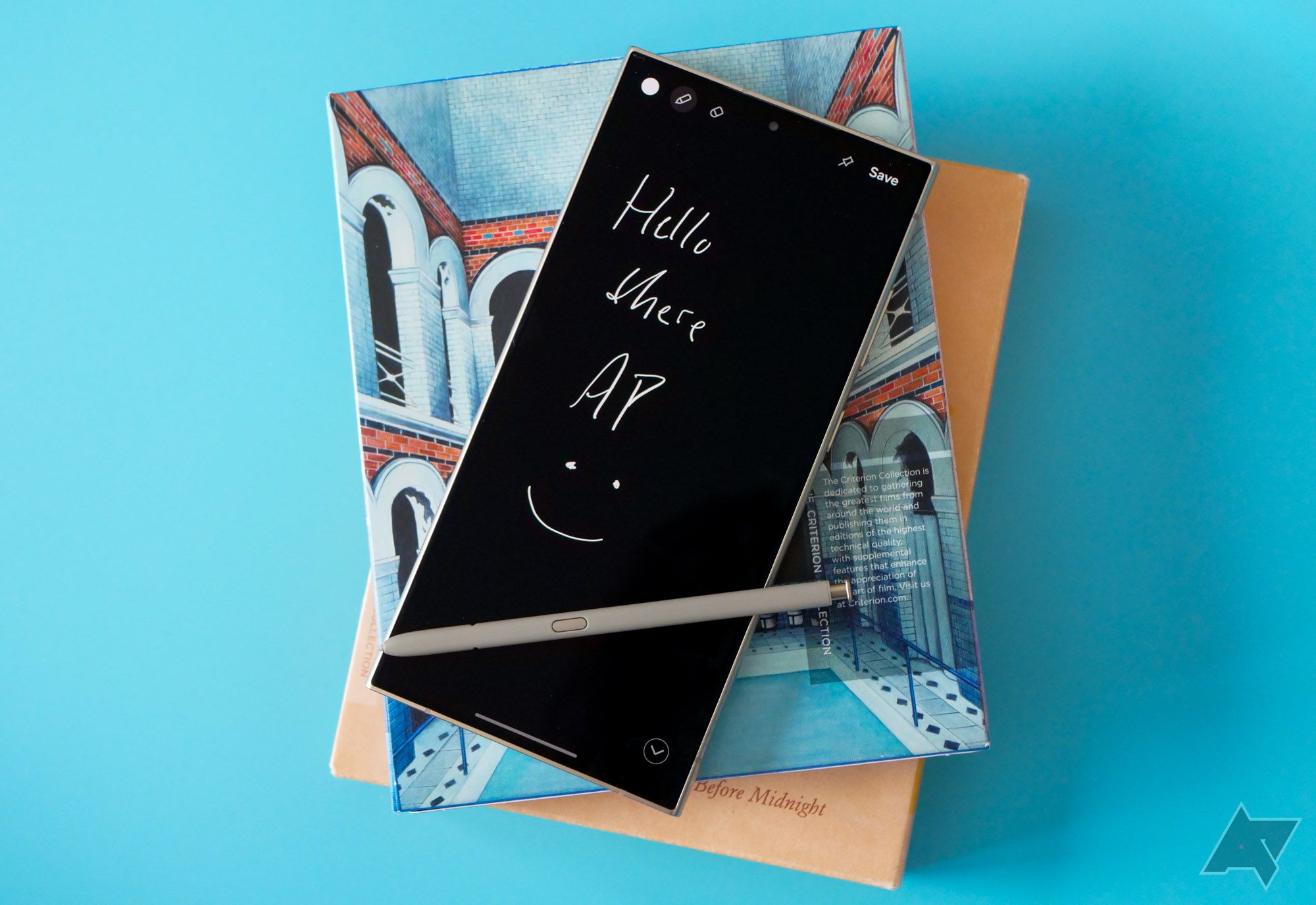
Read Our Review
The Samsung Galaxy S24 Ultra is still the best, unless you take photos
Samsung’s latest phablet feels like a do-over
The other thing that sets the Galaxy S24 Ultra apart is the S Pen. A stylus seems like something made to go along with one of the largest phones on the market — after all, Samsung’s Ultra lineup is the evolution of its Galaxy Note series — and it fits right in on the S24 Ultra. Of course, not everyone wants a stylus, but if you’re a fan of the concept, this is the big phone to buy.
If there’s one area the Galaxy S24 Ultra stumbles a bit, it’s in the cameras. Samsung’s most advanced camera system can produce great photos, and it’s got every zoom factor you could want, but we found that the phone still struggles with motion and shutter speed; you’ll get stunning photos of pastoral scenes and still or slow-moving subjects, but all bets are off for action shots.
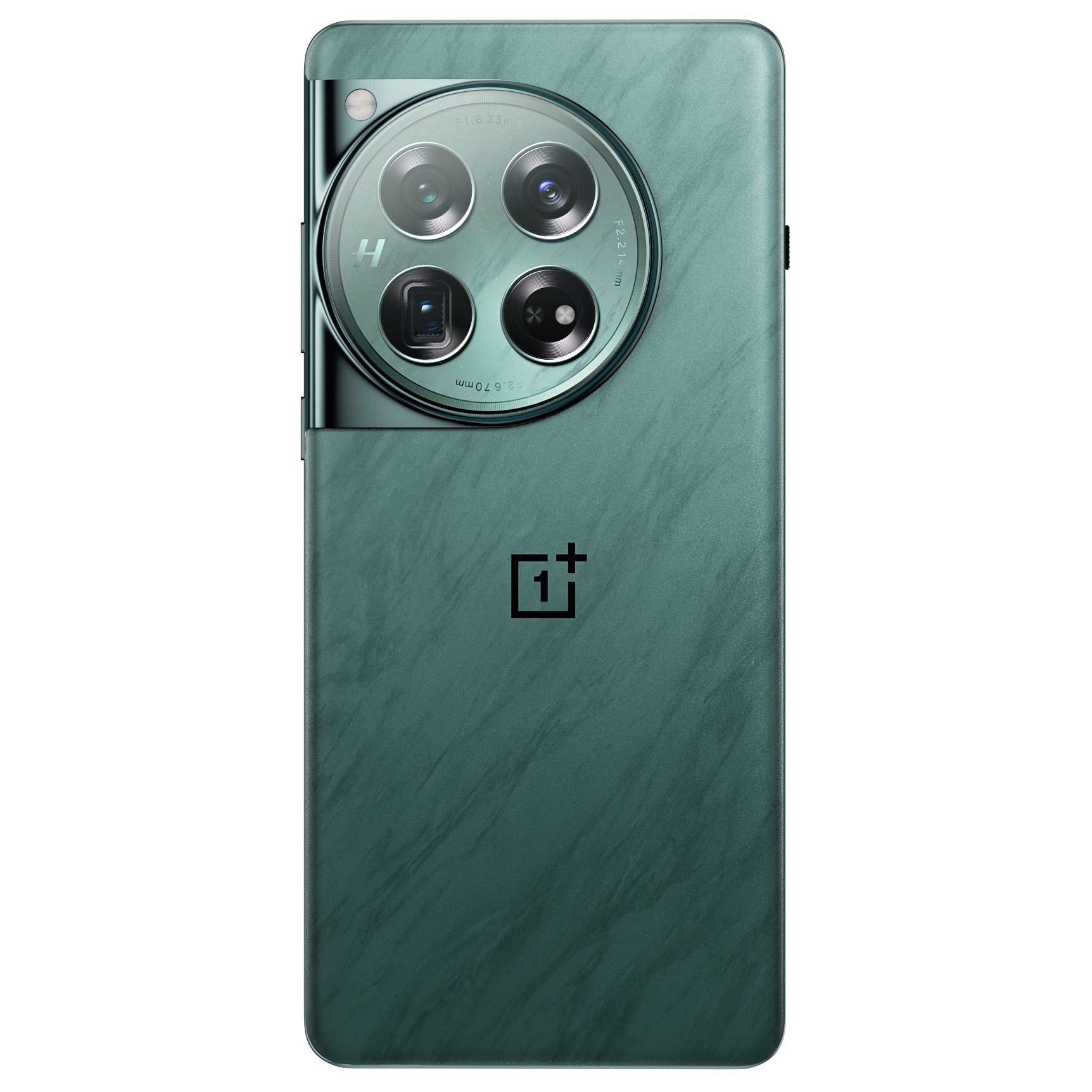
Best value
OnePlus 12
Checks all the right boxes
The OnePlus 12 delivers incredible value, considering that it packs in the same powerful Snapdragon 8 Gen 3 chip as pricier flagships, along with a vibrant and very bright 6.82-inch display. The elegant design boasts a Hasselblad-tuned camera system and wired and wireless charging speeds that are among the fastest you’ll find on any smartphone.
- Excellent performance with a fantastic display
- A highly competent camera system
- Great battery life and super-fast charging
- OxygenOS isn’t for everyone
- Can’t buy at carrier stores
Take one look at the OnePlus 12, and you’ll wonder how such a great-looking smartphone can possibly be a value pick. That just goes to prove that “affordable” doesn’t always mean “boring.”
OnePlus has always been known for its bolder and more opinionated phone designs, and there’s no mistaking the OnePlus 12 for any other smartphone. Recent models have adopted a distinctive rounded camera array that’s worthy of its Hasselblad branding, and the latest model refines that to a more elegant level.
A stylized “H” replaces the full “Hasselblad” word mark, and the metal ring around the outside gives it the feel of a classic watch. The Silky Black and Flowy Emerald colors are also gorgeous.
Under the hood, the OnePlus 12 packs in virtually the same Snapdragon 8 Gen 3 chip as other flagships, which means there’s performance to spare. However, the enthusiast brand has eschewed AI features for now, preferring to focus on raw performance instead, and there’s plenty of that to go around. Expect this phone to handle anything you can throw at it for the next few years.
The front display is a 6.8-inch AMOLED LTPO 1440p panel that reaches an eyeball-searing (and arguably unnecessary) brightness of 4,500 nits. However, what’s more useful here is its support for 2,160Hz pulse width modulation (PWM) dimming, which puts the display in a league of its own for folks who get headaches from looking at flickering OLED screens.
To put that in context, most other smartphones top out at 492Hz PWM dimming, and quite a few are half that.
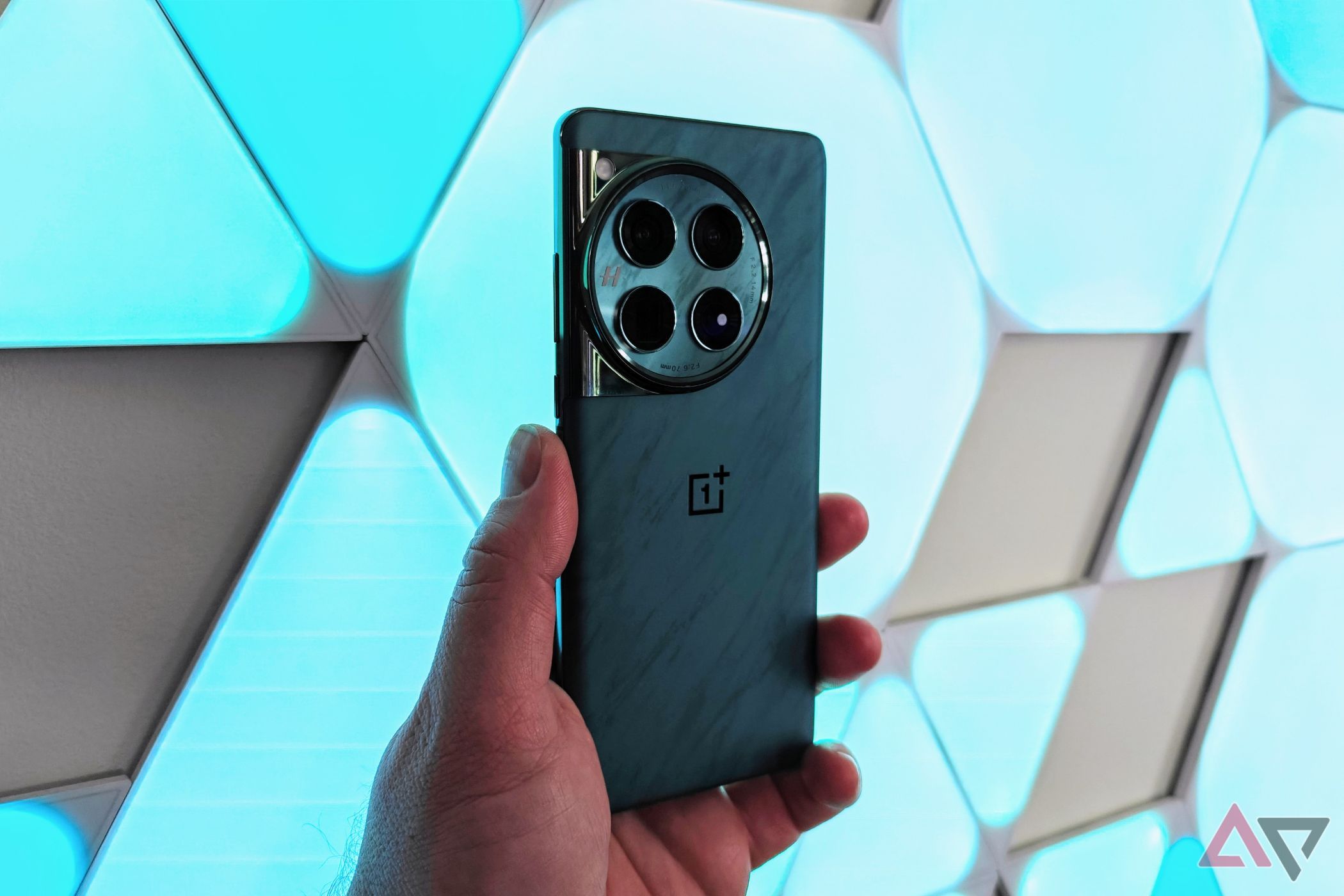
Read our Review
OnePlus 12 review: All flagship, no AI
This phone leaves nothing on the table, making for a truly complete package
While OnePlus may not be the first company you think of when it comes to camera phones, its partnership with Hasselblad has resulted in cameras that are near-perfectly tuned for color balance and saturation.
It’s camera system also delivers bokeh and flare effects that resemble portraits taken from Hasselblad’s XCD 30mm and 65mm professional camera lenses. This is all backed up by a 50MP primary (wide) sensor, a 48MP ultrawide, and a 64MP periscope lens that offers a 3x optical zoom and a pixel-cropped 6x zoom.
However, OnePlus’ real claim to fame is delivering the fastest charging speeds on the market. The adapter that comes in the box provides 80W charging that will take the battery from dead to full in around 30 minutes. You can even get 50W wireless charging if you opt for OnePlus’ AirVOOC charger.
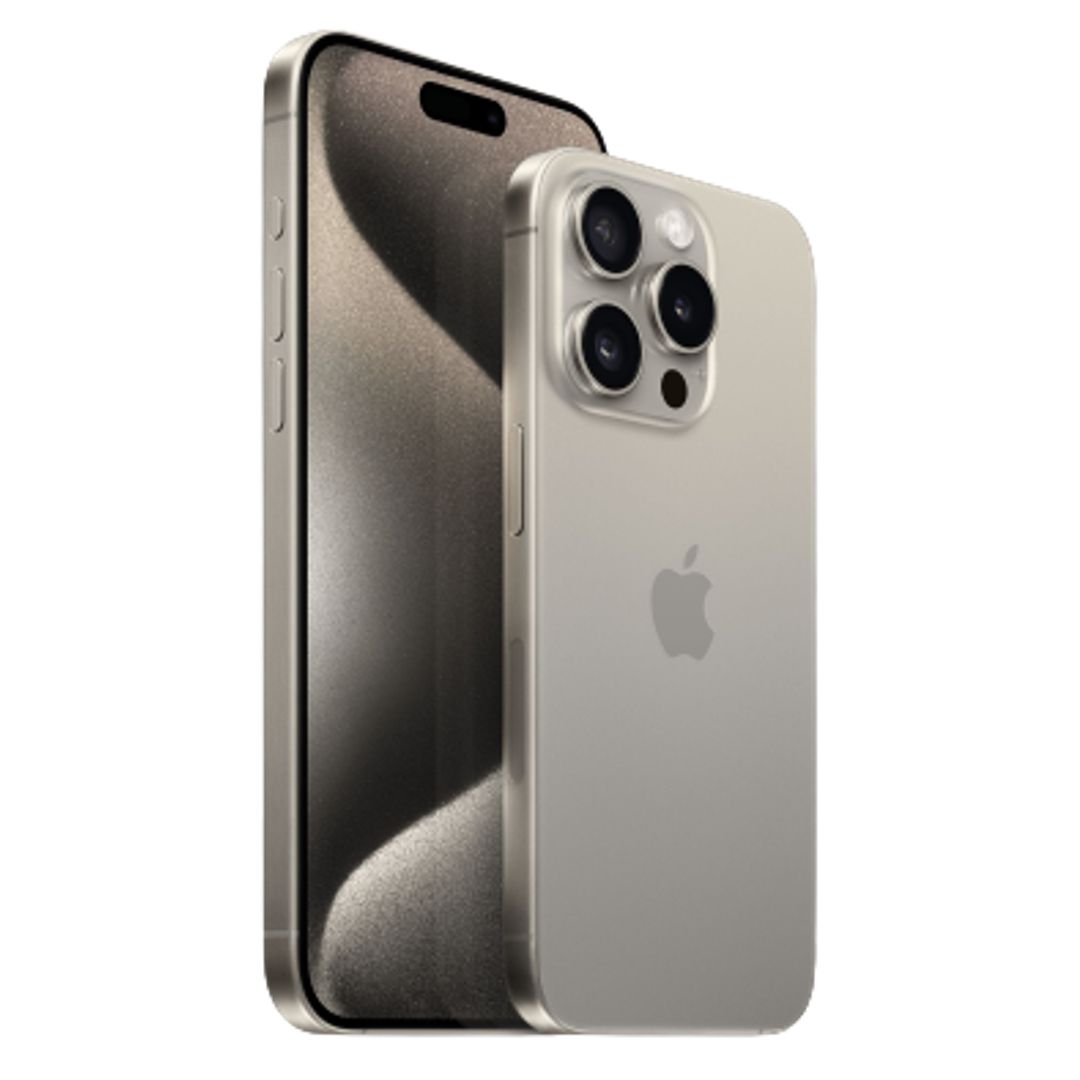
A gaming powerhouse
iPhone 15 Pro Max
Play AAA console games in your pocket
For those willing to dip their toes into the iOS ecosystem, Apple’s iPhone 15 Pro Max has an edge over its Android rivals thanks to a powerful A17 Pro chip that can handle AAA console titles. The camera system is superb, if a bit too clinical, and the titanium frame makes it the lightest big iPhone ever.
- Excellent build quality
- Incredible raw performance
- Solid camera system
- Design is getting stale
- Very expensive
- iOS isn’t everyone’s cup of tea
We’d be remiss if we didn’t offer a fair comparison of how the other side lives. Apple’s iPhone 15 Pro Max is no slouch, and while serious Android fans may find it hard to fathom leaving the familiar world of OneUI and Material Design to embrace the vagaries of iOS, there’s enough in Apple’s latest flagship iPhone to tempt some folks.
For one thing, the iPhone 15 Pro Max packs in what may be the most powerful silicon on any smartphone today, at least in practical terms. Technically speaking, the iPhone’s A17 Pro chip is roughly on par with Qualcomm’s latest Snapdragon 8 Gen 3, although it’s hard to make an apples-to-apples comparison here (pun only slightly intended).
However, what sets the A17 Pro apart is that Apple has managed to convince game developers to get on board in a big way. That’s thanks to a new GPU in the A17 Pro that powers hardware-accelerated ray tracing and Metal effect upscaling to produce a level of graphics quality never before seen on a smartphone.
The practical upshot of this is that the iPhone 15 Pro Max can play actual AAA console games — essentially the same ones that run on your PS5. So far, Apple’s App Store has hits like Resident Evil Village and Assassin’s Creed Mirage, with more to come. Of course, we weren’t surprised that the iPhone heated up quite a bit while pushing Resident Evil at 60fps, but it never stuttered or lagged.
To be fair, this is mostly an indictment of how bad the state of gaming is on Android. There’s every reason to believe the Snapdragon 8 Gen 3 could hold its own against the A17 Pro if only the same powerful game were available, but it is what it is, and the reality is that the iPhone 15 Pro Max is the best game in town for folks who want to do serious console gaming on a smartphone.
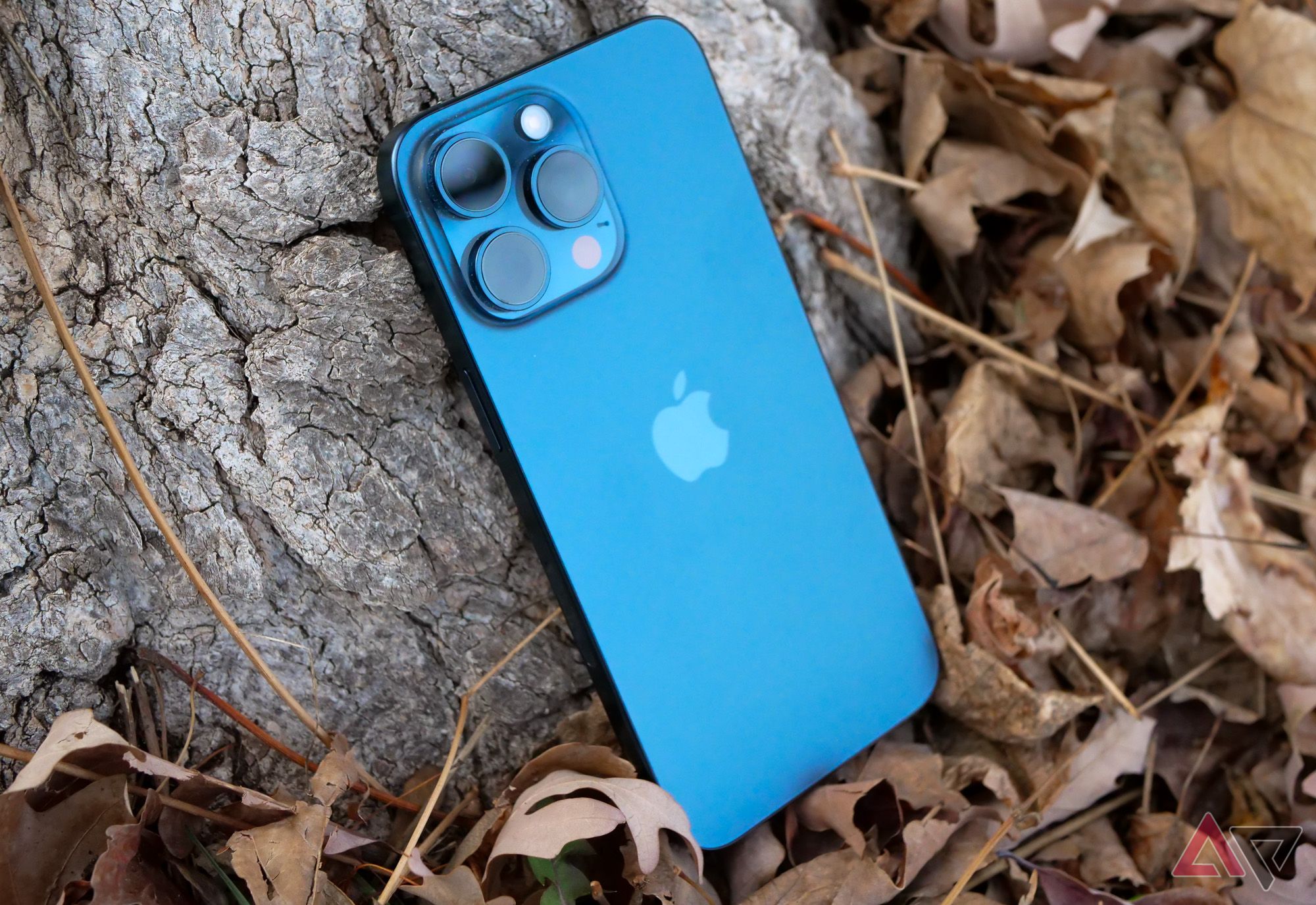
Read Our Review
iPhone 15 Pro Max review: The phone everyone else is choosing
The bubbles might be bluer, but is the grass greener?
The iPhone 15 Pro Max also holds its own against the best Android smartphones in camera quality, especially now that Apple has finally gotten with the program and given us a 5x telephoto lens.
The camera system is rock solid and dependable under just about every condition, but in reviewing the phone, we found it lacked “a certain spark, a je ne sais quoi aspect that keeps mobile photography interesting.” Photos were technically accurate, but perhaps too much sometimes; many images came out feeling more clinical.
That’s been a common complaint with Apple’s photographic engine over the years, and while the iPhone 15 Pro Max does better than its predecessor, it’s still behind the curve compared to the fun pictures the best Android camera phones can capture.
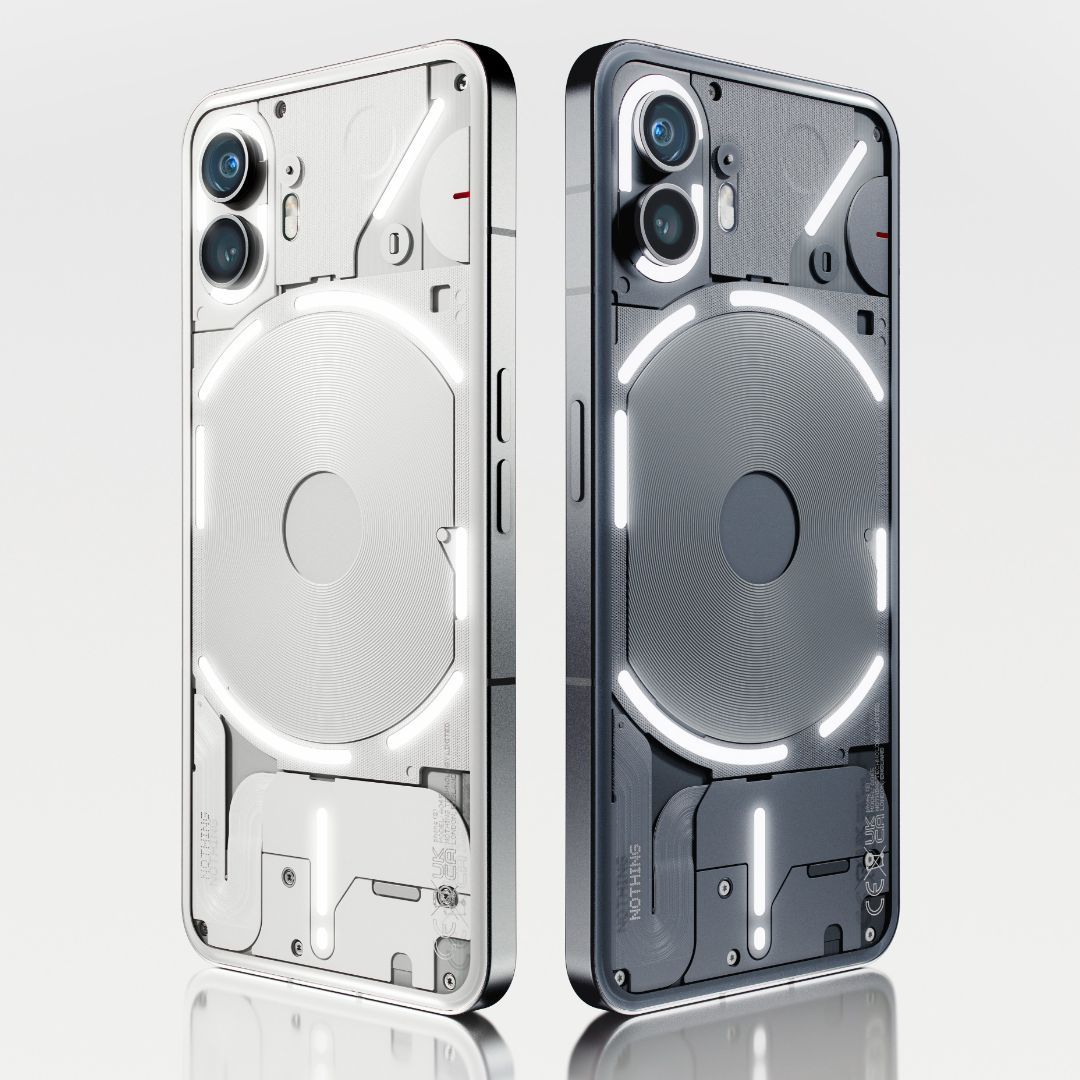
Fun and unique
Nothing Phone 2
Lights up your smartphone experience in a whole new way
The Nothing Phone 2 is unlike any other smartphone we’ve ever seen, thanks to its transparent back and fun and useful Glyph lights. The Snapdragon 8+ Gen 1 chipset delivers snappy performance, even for mobile gaming, the screen is vibrant and sharp, and the cameras produce solid results.
- Cool futuristic design
- Glyph lights are fun and useful
- All-day battery life and then some
- Cameras are hit-and-miss
- Not available through carriers
If you’re looking for something completely different in a smartphone design, the Nothing Phone 2 might be it. Like its predecessor, the second-generation Nothing Phone features an aesthetic that’s entirely unique and stands out from the rest of the pack without sacrificing build quality or attention to detail.
That’s thanks to its transparent back and fun Glyph lights that give it a futuristic, cyberpunk style, and play off the textured components under the back panel. However, the lights can also communicate a lot of helpful information, from notifications and timers to charge levels, and even double as fill lights for the rear cameras. You can also customize them to set distinct patterns for your favorite apps.
The Nothing Phone 2 isn’t the largest phone on this list, but it still sports a 6.7-inch OLED screen with a full 120Hz dynamic refresh rate and reasonably narrow bezels. It’s vibrant and sharp, with good viewing angles, and looks great with the default monochromatic skin in Nothing OS 2.5, which is designed to complement the phone’s design. However, you’re not obligated to stick with that if you prefer something more colorful.
Under the hood, the Nothing Phone 2 is powered by the 2022 Qualcomm Snapdragon 8+ Gen 1. That’s not a bad thing, as that midterm Qualcomm SoC is surprisingly power efficient and runs pretty cool. We found everyday performance snappy and gaming performance reliable and smooth, provided you’re not trying to push frame rates to the max.
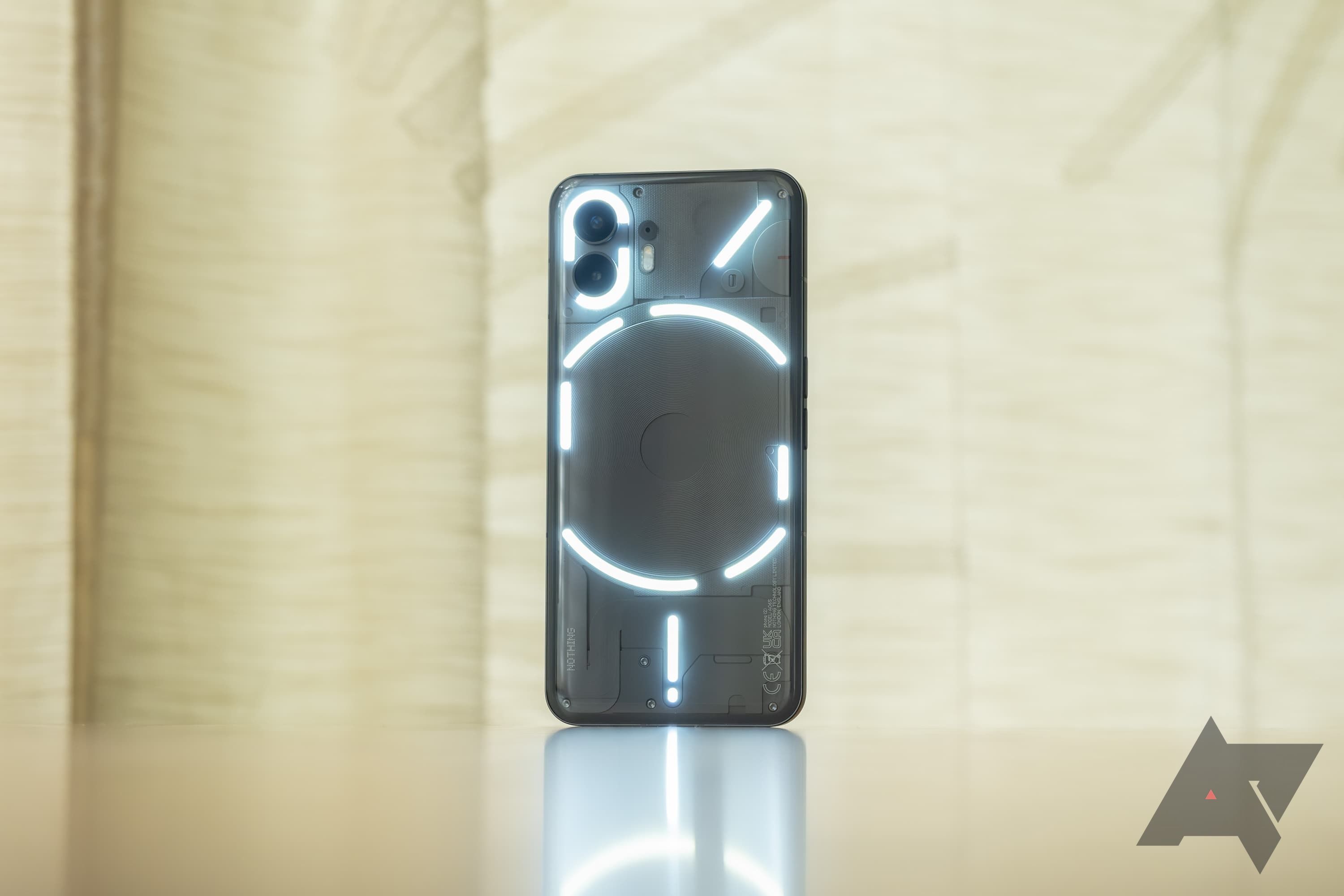
Read our Review
Nothing Phone 2 review: Finding its niche
Nothing’s first US smartphone is (mostly) a success
Around the back, the dual-camera system combines a pair of 50-megapixel shooters in the typical primary (wide) and ultrawide configuration. We found it typically took good pictures, holding its own against most others in its price range under optimal conditions. It had sharp detail and better contrast than most — dark shadows and blacks that actually looked black.
Unfortunately, its processing seems to remove some of the detail when shooting high-contrast scenes, and slower shutter speeds in dark settings can make it hard to capture handheld photos.
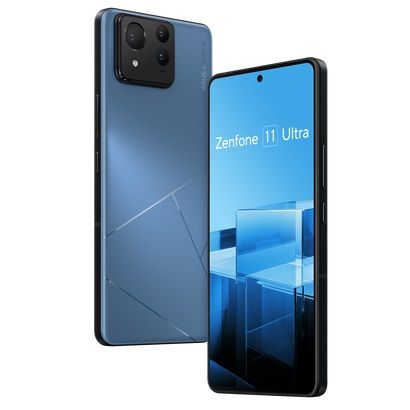
Broadly appealing
Asus Zenfone 11 Ultra
Big, classy, and premium
Asus’ has decided to go big with its Zenfone 11 Ultra, but there’s more here than just size. It’s a complete flagship with an elegant but understated look that belies its premium specs. Those include a top-tier Snapdragon 8 Gen 3 chip, a robust camera system, and a vibrant high-refresh display.
- Gorgeous and responsive display
- Great performance and battery life
- Surprisingly good cameras
- Slippery back panel
- Cameras struggle in awkward lighting conditions
Asus decided to change its playbook this year and go big or go home with the Zenfone 11 Ultra, a massive piece of kit that’s a stark departure from the company’s tradition of making smaller phones. As tiny as the Zenfone 10 was by today’s standards, the Zenfone 11 Ultra goes in the other direction, being taller and thicker than even the Samsung Galaxy S24 Ultra.
However, Asus has gone with an unassuming design that belies the phone’s larger size, which helps it avoid being ostentatious like their ROG phones. Instead, it looks more elegant and classy in professional shades like Misty Gray, Skyline Blue, or Desert Sand, as long as you can get past the rectangular camera bump and the off-center USB-C port on the bottom.
With great size usually comes a great screen, and the Zenfone 11 Ultra doesn’t disappoint. The 6.78-inch LTPO AMOLED display has a 120Hz refresh rate that, in classic Asus style, can go up to 144Hz, along with HDR10 support and 2,500 nits of peak brightness. However, we found it also got dim enough not to sear our eyeballs when used in a dark room.
Despite the Asus brand, the Zenfone 11 Ultra isn’t specifically a gaming phone, but it does have the Snapdragon 8 Gen 3 chip and a generous 16GB of RAM, so you’ll have no problem playing anything on the Play Store — we ran demanding games for over three hours without even a hint of throttling or excessive heat.
Asus has also brought over a few of its gaming features from its ROG lineup to help you keep an eye on stats like temperature, clock speed, and battery, plus macros and screen recording.
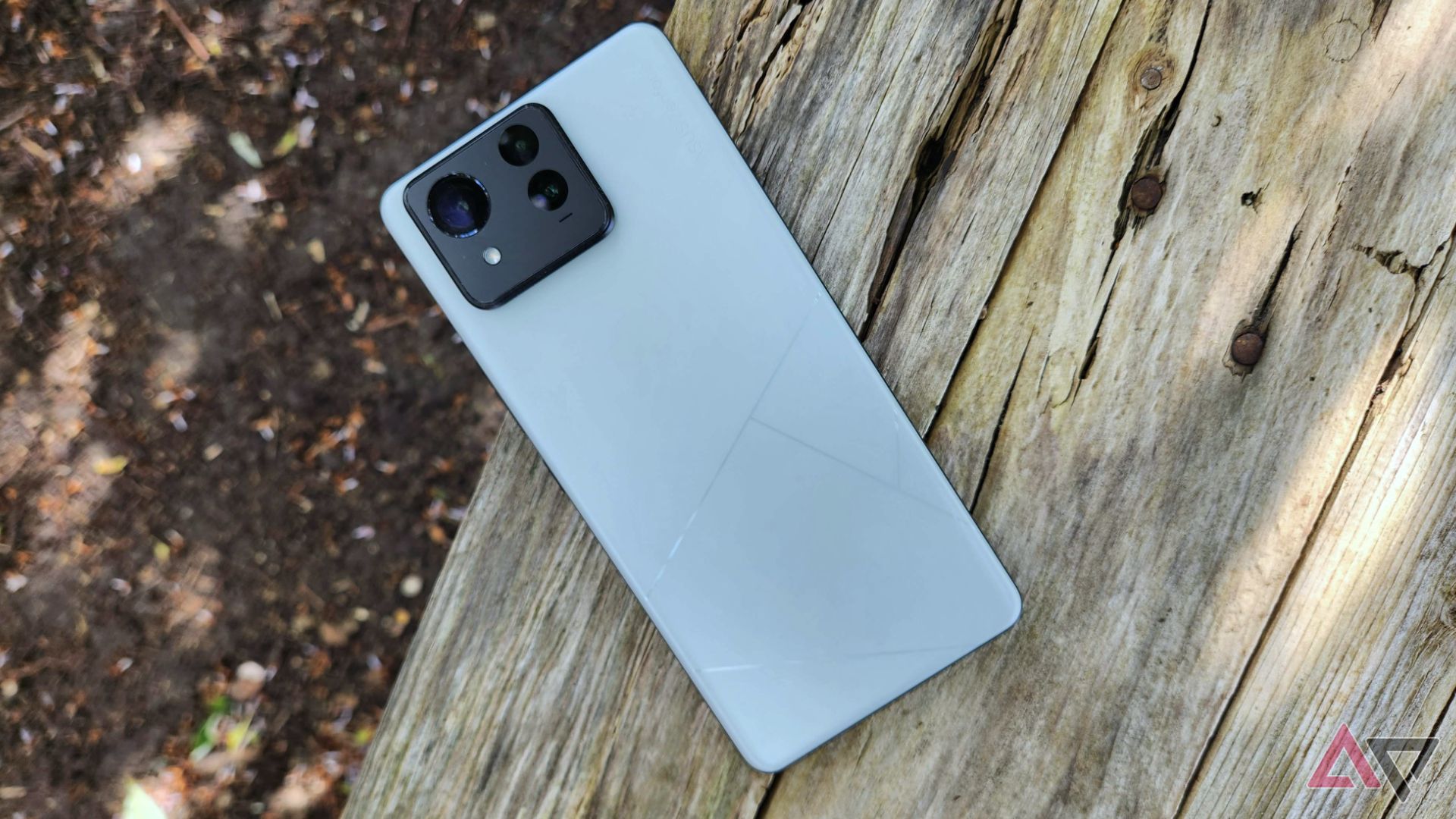
Read our review
Asus Zenfone 11 Ultra review: They grow up too fast
A solid all-rounder that only comes in a large
Asus worked hard with the ROG Phone 8 Pro to prove that gaming phones can still have robust camera systems. The Zenfone 11 Ultra adopts the same configuration the company pioneered for that gaming model, resulting in solid photographic performance for a phone in its class. In daytime lighting, it delivers natural and balanced photos that have good contrast and don’t feel overly sharpened or processed.
Still, we found the dynamic range wasn’t always consistent, with the highlights sometimes being blown out, and the portrait mode feature was similarly lacking. Evening shots also tended to produce photos that were merely okay.
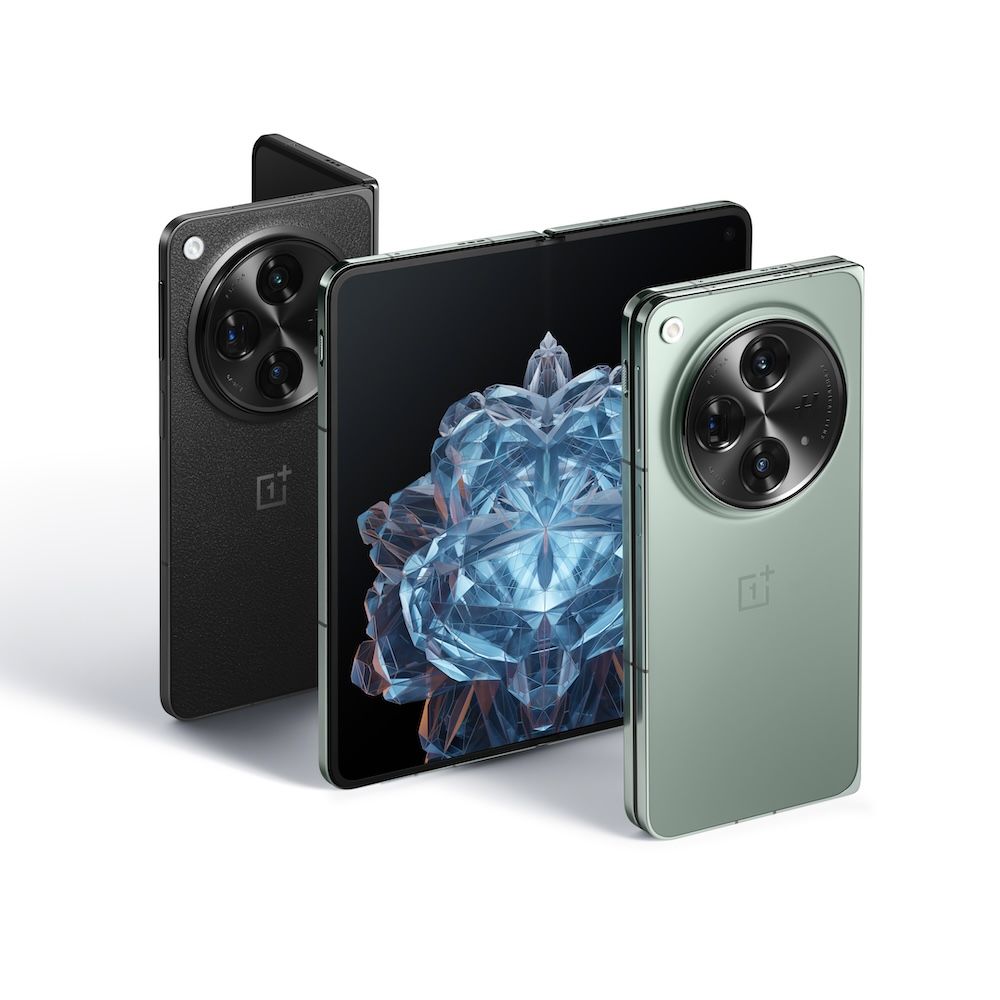
Best foldable
OnePlus Open
Everything a foldable should be
OnePlus has hit it out of the park with its first foldable, raising the bar for what a foldable should be. The design is lightweight, the cover screen is roomy and bright, the inside crease is nearly invisible, and the Hasselblad-tuned triple-camera system is the best we’ve seen on any foldable.
- Excellent battery life and performance
- Big screen is very customizable
- Great camera by foldable standards
- OxygenOS isn’t quite ready for prime time
- Lacks wireless charging
If choosing a big phone means getting the most screen real estate possible, then a foldable phone is hard to beat, and the OnePlus Open provides an ideal balance of design, screen quality, and camera features. It was the enthusiast brand’s first entry into the space, but it came out swinging hard and produced a phone that set a new standard for what foldable phones should be.
The design remains unmistakably OnePlus, including the round camera array on the back with the subtle Hasselblad logo etched in. As with any foldable, it’s much thicker when closed, but that’s worth the trade-off when you open it up and see the expansive 7.82-inch AMOLED screen on the inside with its anti-reflective coating and — miraculously — a crease that’s nearly invisible.
You’ll have no problem seeing it in daylight, and the outer 6.3-inch display also offers the same specs as the main screen, plus an aspect ratio that makes it feel more like you’re using a regular smartphone — a refreshing change from the narrower cover screens found on Samsung’s foldables.
The hinge on the OnePlus Open is more of a mixed bag. Although we found it felt durable and easy to open, and it closes entirely flat with no gaps, it didn’t open fully flat without applying some pressure and had a hard time staying put at the angles we liked, likely due to a combination of the springy hinge and weighty camera bump.
The OnePlus Open also offers some of the best cameras you’ll find on a foldable, since it has the same signature Hasselblad tuning as its non-foldable flagship. There’s no heavy AI processing here, and we found the phone captured pictures that looked very true-to-life, with only a gentle touch of refinement from the Hasselblad color science algorithms.
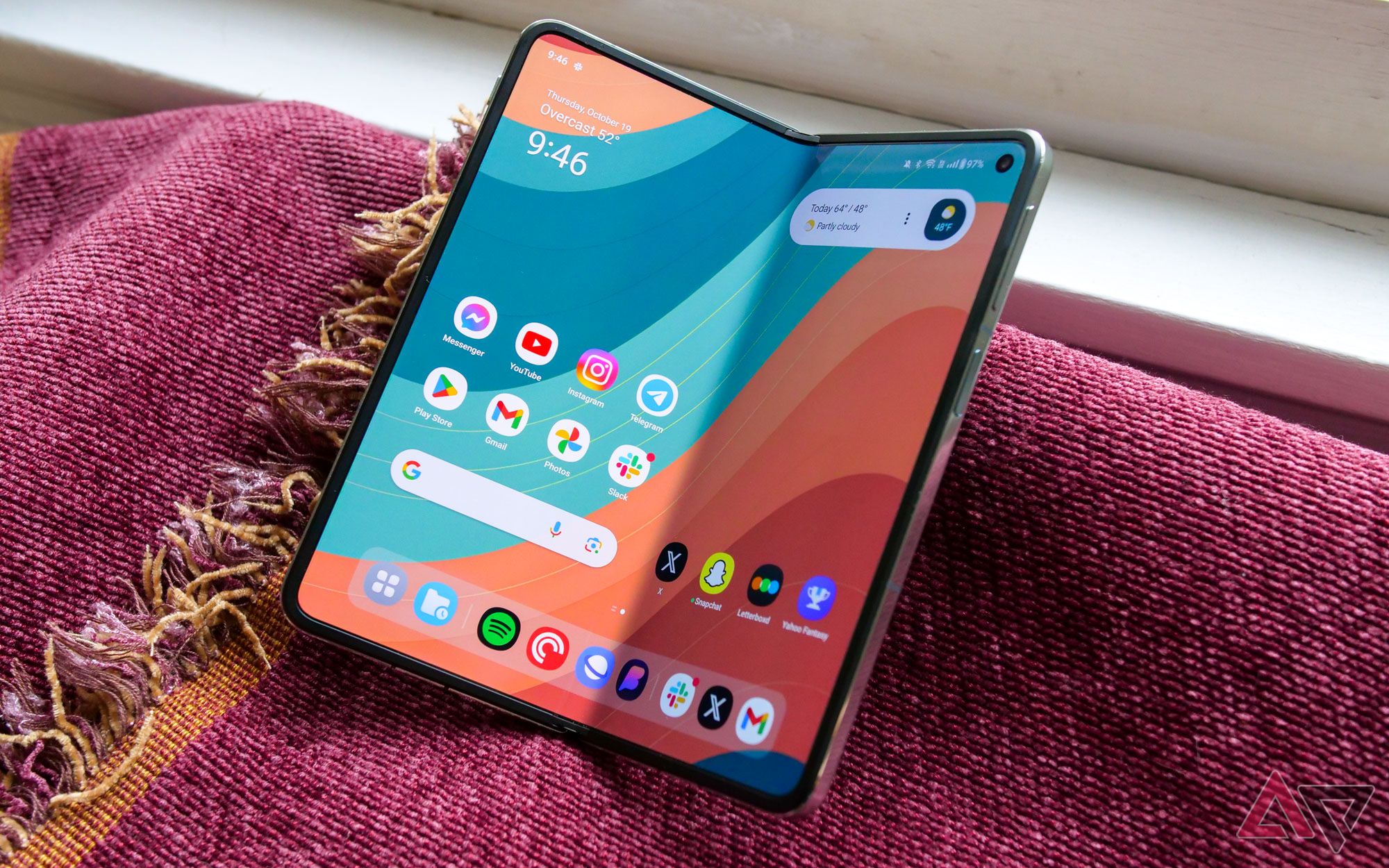
Read our review
The OnePlus Open is what every foldable should be
OnePlus supplies the competition Samsung needs
It also shouldn’t be a surprise that the OnePlus Open matches the rest of the family in delivering excellent battery life and ultrafast charging. It’s the longest-lasting foldable on the market right now, easily getting you through a full day and then some, with 67W wired charging to top you back up quickly in the event that you do run out of juice.
The catch is there’s no wireless charging at all. Thankfully, the excellent battery life means you won’t need to carry a charger around, but you’ll still have to plug it in at night.
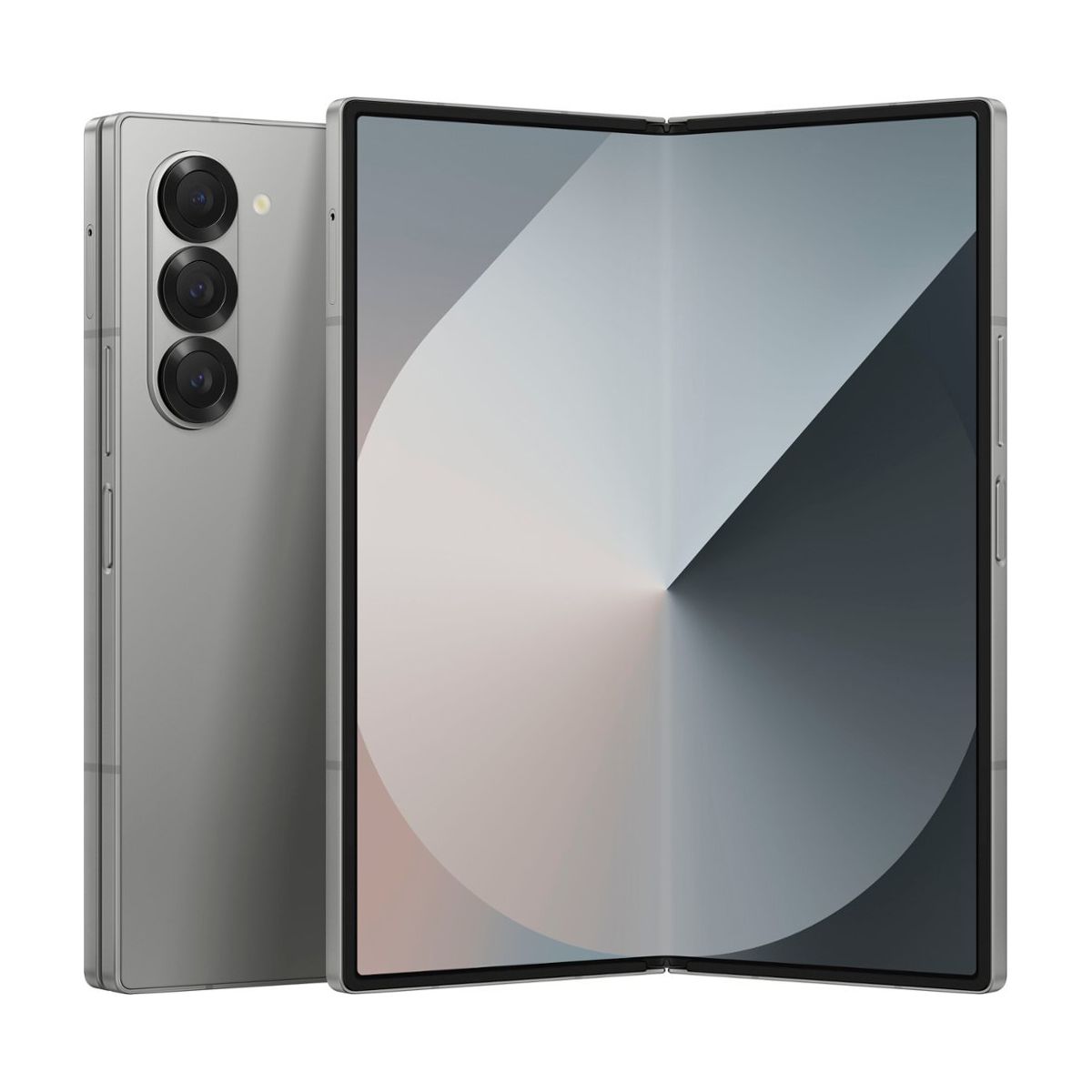
The venerable foldable
Samsung Galaxy Z Fold 6
Samsung hits its design stride
Samsung defined the modern era of foldable smartphones, and the Galaxy Z Fold 6 takes things to a new level with a fit and finish that leaves its predecessors in the dust. Still, for better or worse, it’s the same old Galaxy Z Fold we’ve known for years, with only iterative improvements.
- Thinner, lighter, and more pocketable
- Refined design takes things up a bit notch
- Great OneUI software experience
- Awkwardly narrow front display
- Galaxy AI is more gimmicky than useful
- Needlessly pricier
Following a shaky initial release five years ago, Samsung became the first company to really nail a mass-market foldable. The Galaxy Z Fold 6 is the latest evolution of that, although it’s important to note that we said “evolution,” not “revolution.”
Of course, fans of Samsung’s early Z Fold phones can argue that it’s hard to improve on what’s long been the best foldable on the market, and it’s clear that Samsung is taking that to heart. The Galaxy Z Fold 6 looks suspiciously like the Galaxy Z Fold 5 while boasting a much more refined design. This means it may not be the most exciting foldable, but it’s undoubtedly the most polished, even if it seems to fall behind its rivals.
The Galaxy Z Fold 6 is thinner and lighter than ever, although it’s still only on par with the competition. However, the design now feels delightfully premium thanks to the matte frame, sharper corners, and vinyl-like bezels on the camera lenses. It’s a class act, and opening it up reveals a gorgeous 7.6-inch display that has all the quality we’ve come to expect from Samsung.
That said, it’s a bit wider than previous models, which we found made typing a bit uncomfortable, and the 6.3-inch cover screen still has the same awkward 22:9 aspect ratio as prior models, which makes it feel a bit cramped.
Naturally, the Galaxy Z Fold 6 gets the same Snapdragon 8 Gen 3 for Galaxy chip that came to the S24 lineup earlier this year, so it has no problem with multitasking and gaming. It’s worth mentioning that we found some odd behavior in our testing that suggests Samsung’s OneUI software may need some more polish, although it still has the same thoughtful touches that made One UI feel at home on the foldable design.
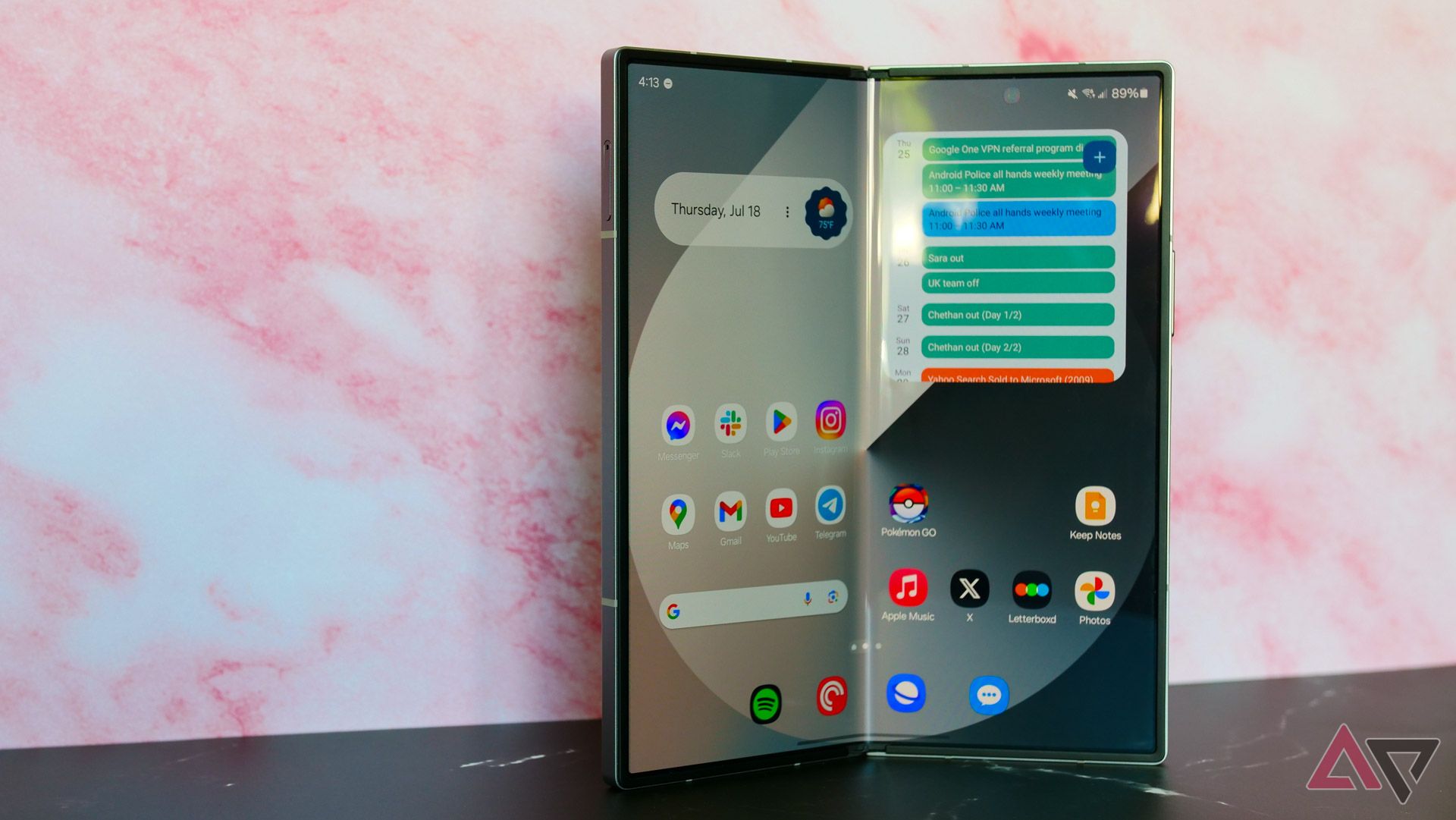
Read our Review
Review: The Galaxy Z Fold 6 has cost Samsung its head start in the foldable race
A real tortoise-and-hare situation
As usual, Samsung saved its best camera systems for its Galaxy S-series models, with the Galaxy Z Fold 6’s cameras being adequate, but nothing special. They’re identical to the Galaxy Z Fold 5, and we found they suffered from similar motion issues as the Galaxy S24 Ultra, plus some confusing focus issues or overexposure. They’ll produce good shots, but this isn’t a foldable for mobile photography.
Similarly, battery life is good, and should get you through a full day, but we found it as inconsistent as it was on the Galaxy Z Fold 5, and wired charging is still limited to 25W speeds, although at least you can take advantage of 15W wireless charging here.
Make the best of a big phone
The demand for larger screens means there’s no shortage of plus-sized Android phones on the market today, but bigger doesn’t automatically mean better. After all, anyone can slap a big display onto a smartphone, but that doesn’t mean it’s a quality screen, and the other specs under the hood may still fall woefully short of what a flagship delivers.
Of course, there’s nothing wrong with that if you’re looking for a budget smartphone. You can still get some great phones in the lower midrange with 6.7-inch or larger screens for a little under $500, but you’ll often do significantly better by spending a bit more, so why not get some extra power to go along with that size?
For instance, our value pick, the OnePlus 12, uses the same Snapdragon 8 Gen 3 chip as the Galaxy S24 Ultra, but it’s around half the price of that premium model. It also has a vibrant display, a great camera system, and exceptionally fast charging.
Still, if you’re looking for the most well-rounded experience, Google’s Pixel 8 Pro does nearly everything right at a very affordable price. It continues to offer the best camera capabilities on the market, and the new Tensor G3 chip finally offers more than just powerful AI features, with raw performance that can handle gaming without draining the battery or overheating the phone. You’ll also get seven years of Android updates.
Then there’s Samsung’s Galaxy S24 Ultra, a premium phone that pulls out all the stops. The display is top-notch, the new flat design and titanium frame give it a nice sheen of elegance, and the advanced camera system is versatile and delivers solid results in most cases. The Snapdragon 8 Gen 3 for Galaxy chip also has power to spare, which means this phone will last you well into the future, thanks to seven years of software updates.

Best overall
Google Pixel 8 Pro
Google’s Pixel 8 Pro remains the master of all trades, offering the best camera system available today, powerful AI features that are actually useful, and a Tensor G3 chip that delivers new levels of performance and efficiency that go beyond computational photography.
Source link
